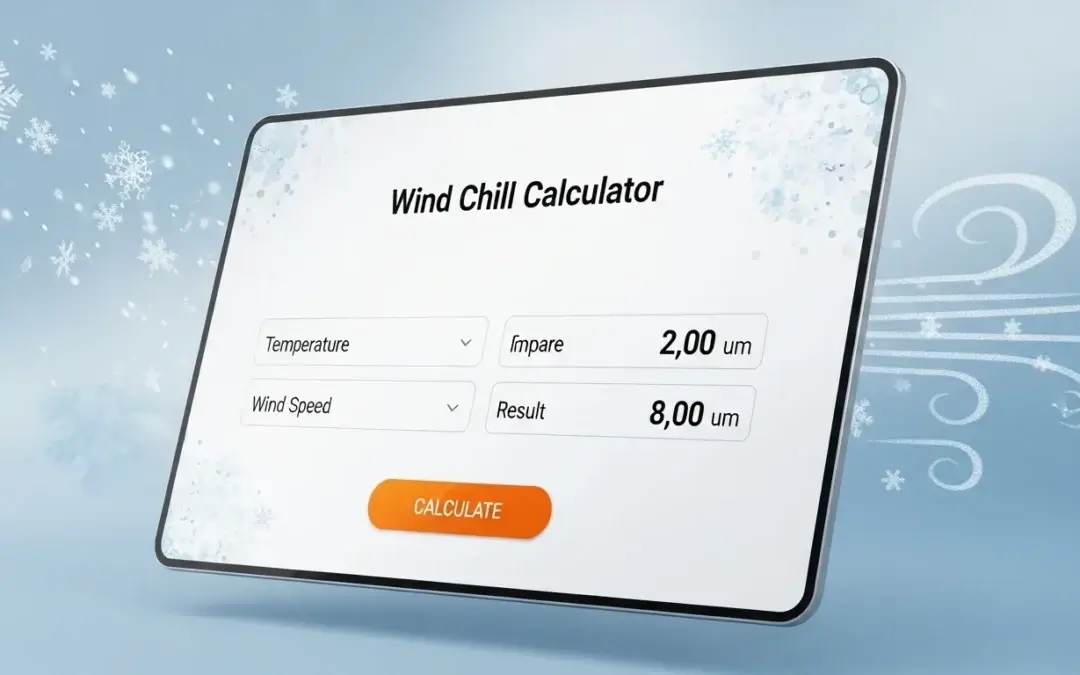Wind Chill Calculator
Calculate how cold the weather feels on your skin
Wind Chill Calculator: How to Measure the Real Feel of Cold Weather
Understanding wind chill is crucial for safety, especially in extreme winter conditions.
Introduction to Wind Chill
Wind chill is the perceived drop in temperature caused by wind, making cold weather feel even harsher on exposed skin. For example, if the actual temperature is 20°F with a 15 mph wind, the wind chill might make it feel like 5°F. Understanding wind chill is crucial for safety, especially in extreme winter conditions.
At 907 Heating and Plumbing, we care about your well-being during freezing weather. While we specialize in plumbing and heating services, we also want you to stay informed about weather risks—like frozen pipes, which can burst due to extreme wind chill.
How a Wind Chill Calculator Works
A wind chill calculator uses temperature and wind speed to determine the “feels-like” temperature. The National Weather Service (NWS) and NOAA use the following formula:
Wind Chill (°F) = 35.74 + 0.6215T – 35.75(V^0.16) + 0.4275T(V^0.16)
T = Air Temperature (°F)
V = Wind Speed (mph)
Wind Chill Chart for Quick Reference
| Temperature (°F) | Wind Speed (mph) | Feels Like (°F) |
|---|---|---|
| 20°F | 10 mph | 9°F |
| 10°F | 20 mph | -10°F |
| 0°F | 30 mph | -25°F |
*Note: Frostbite can occur in under 30 minutes when wind chill drops below -20°F.*
Why Wind Chill Matters for Home Safety
Extreme wind chill doesn’t just affect people—it also impacts your plumbing and heating systems. Here’s how:
1. Frozen Pipes Risk
Pipes can freeze when wind chill drops below 20°F for extended periods.
Solution: Insulate pipes and keep faucets dripping to prevent bursts.
2. Heating System Strain
HVAC systems work harder in extreme cold, increasing wear and tear.
Solution: Schedule a professional heating checkup before winter.
At 907 Heating and Plumbing, we offer emergency plumbing repairs and heating maintenance to keep your home safe in freezing weather.
Wind Chill vs. Actual Temperature: Key Differences
- Wind Chill affects only living beings (humans, animals).
- Actual Temperature determines whether water freezes (32°F).
Myth:
Wind chill can freeze car engines or water pipes.
Fact:
Only actual temperature causes freezing—but wind chill speeds up heat loss.
Wind Chill Safety Tips
To protect yourself and your home:
For Personal Safety:
- ✔ Cover exposed skin in high wind chill conditions.
- ✔ Limit outdoor time when wind chill is below -10°F.
- ✔ Recognize early signs of frostbite (numbness, pale skin).
For Home Protection:
- ✔ Insulate exposed pipes (especially in attics/basements).
- ✔ Let faucets drip slightly to prevent freezing.
- ✔ Ensure your furnace is working efficiently—call 907 Heating and Plumbing for a tune-up.
FAQs About Wind Chill
1. Can wind chill freeze pipes?
No, only actual temperature freezes pipes—but wind chill accelerates heat loss, making pipes more vulnerable.
2. What’s the highest recorded wind chill?
In Antarctica, wind chill reached -100°F due to extreme winds and subzero temps.
3. How accurate are wind chill calculators?
They follow the NOAA standard formula, making them reliable for safety planning.
Final Thoughts: Stay Warm & Protect Your Home
Understanding wind chill helps you prepare for extreme cold. If your heating system fails or pipes freeze, 907 Heating and Plumbing is here to help with 24/7 emergency services.
Need winter-ready plumbing or heating help? Contact us today!

